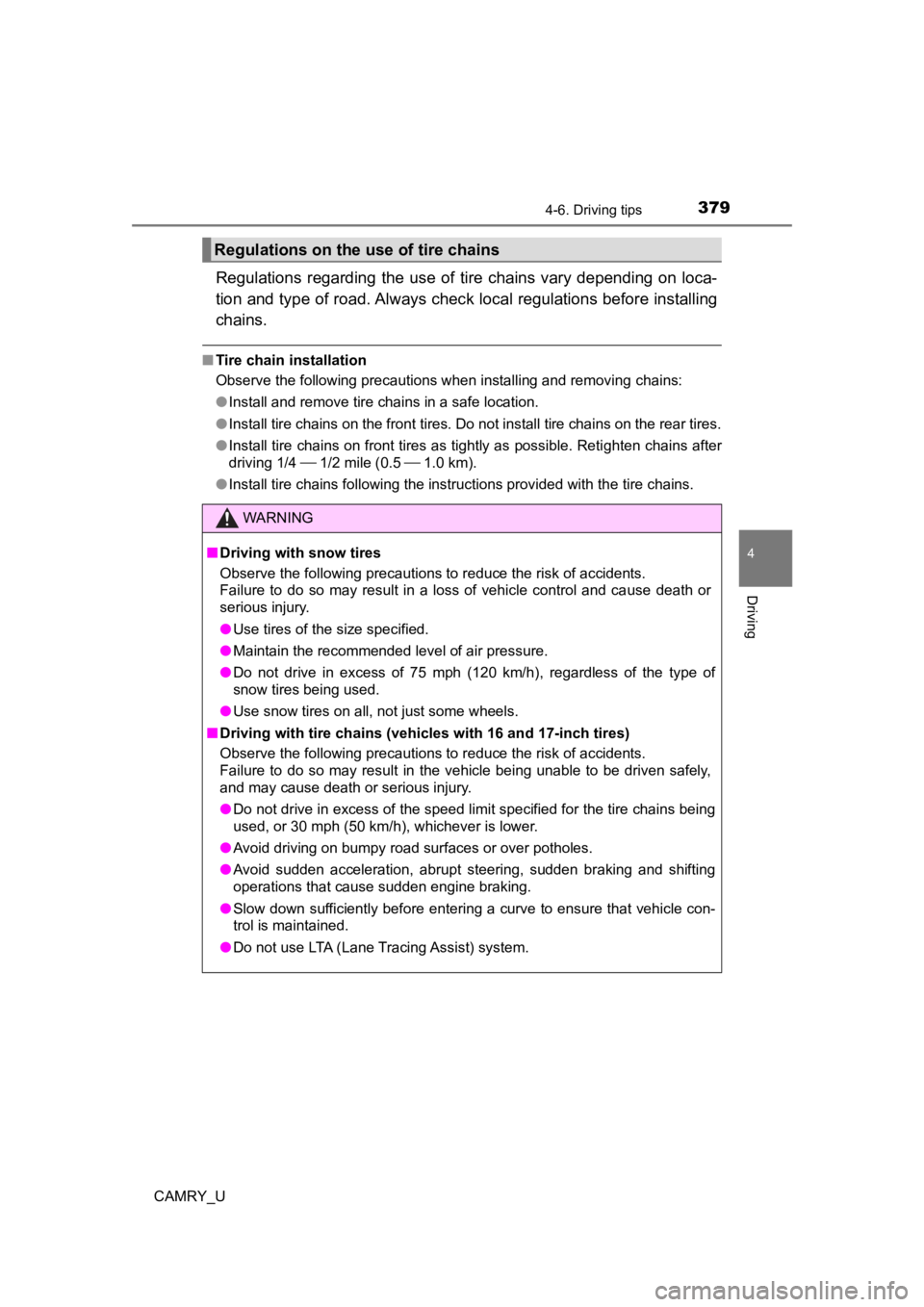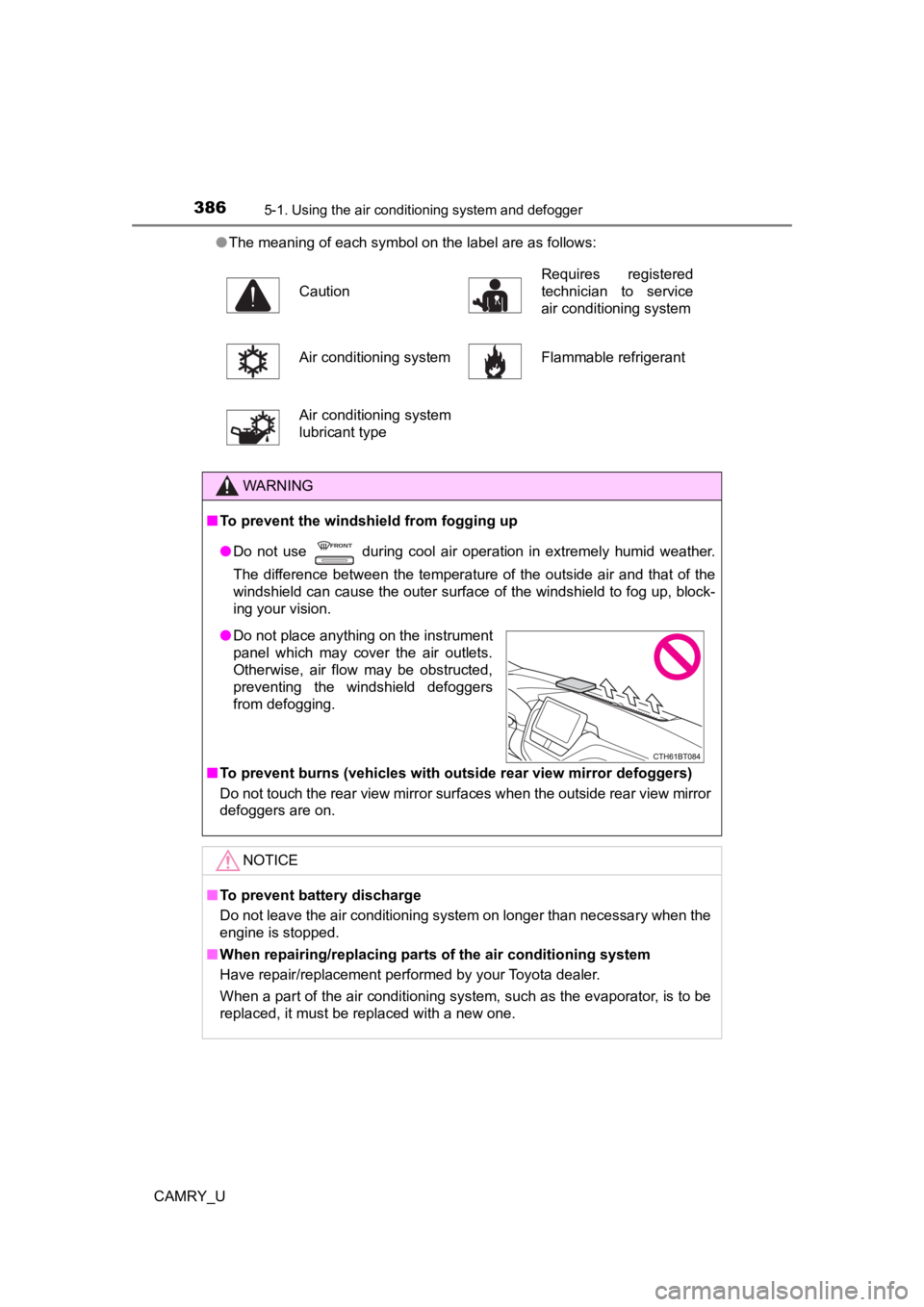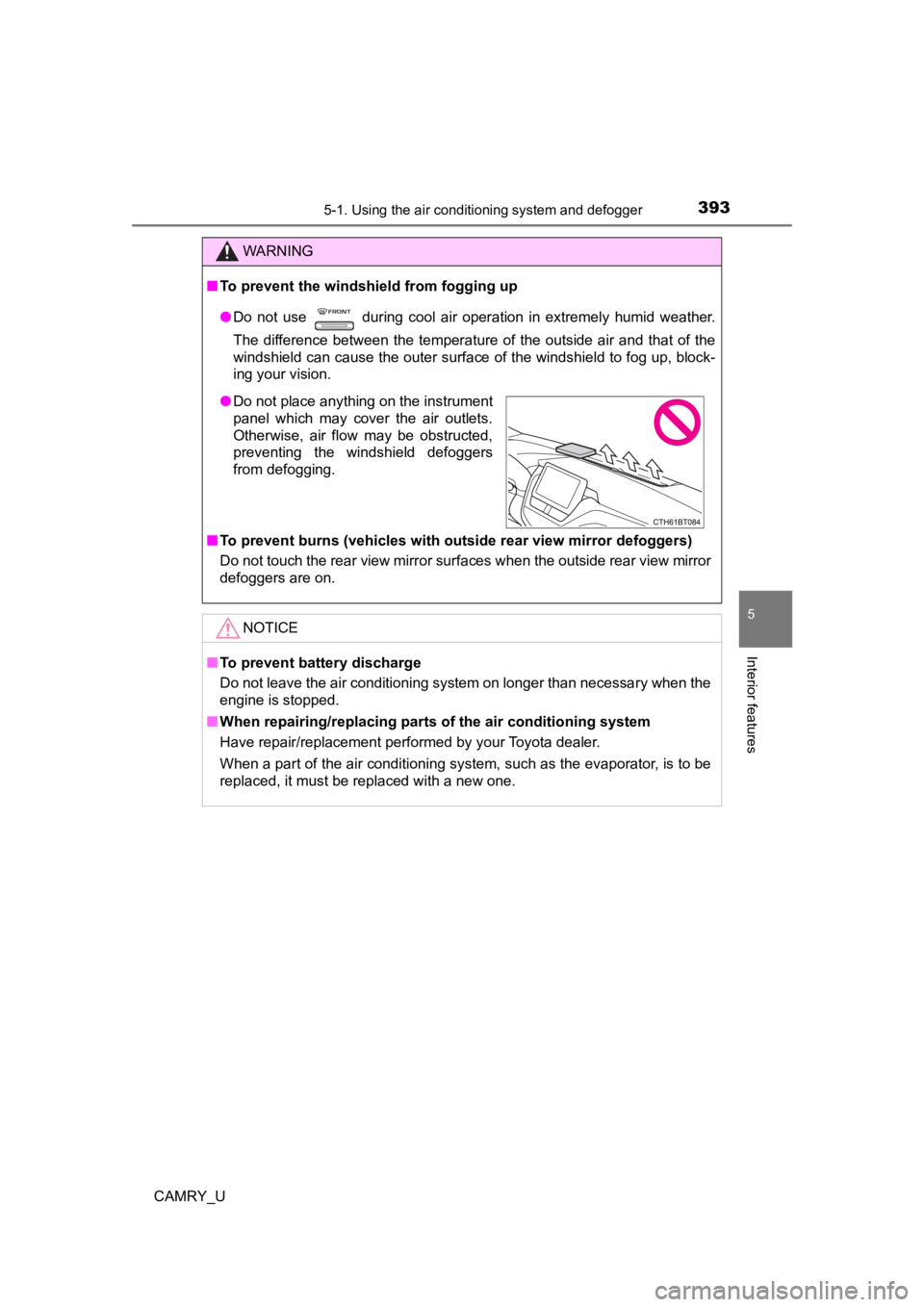Page 370 of 664

3704-5. Using the driving support systems
CAMRY_U
■The Parking Support Br ake function (static objects) will operate when
The function will operate when the PKSB OFF indicator is not illuminated
( P. 361, 365) and all of the following conditions are met:
● Engine output restriction control
• The Parking Support Brake system is enabled.
• The vehicle speed is approximately 10 mph (15 km/h) or less.
• There is an object in the traveling direction of the vehicle a nd approxi-
mately 6 to 13 ft. (2 to 4 m) away.
• The system determines that a stronger-than-normal brake operat ion is
necessary to avoid a collision.
● Brake control
• Engine output restriction control is operating.
• The system determines that an emergency brake operation is nec essary
to avoid a collision.
■ The Parking Support B rake function (static objects) will stop o perating
when
The function will stop operating if any of the following condit ions are met:
● Engine output restriction control
• The Parking Support Brake system is disabled.
• The collision becomes avoidable with normal brake operation.
• The object is no longer approximately 6 to 13 ft. (2 to 4 m) away in the
traveling direction of the vehicle.
● Brake control
• The Parking Support Brake system is disabled.
• Approximately 2 seconds elapse after the vehicle is stopped by brake
control.
• The brake pedal is depressed after the vehicle is stopped by b rake con-
trol.
• The object is no longer approximately 6 to 13 ft. (2 to 4 m) away in the traveling direction of the vehicle.
■ Detection range of the Parking Support Brake function (static objects)
The detection range of the Parking Support Brake function diffe rs from the
detection range of the intuitive parking assist. ( P. 339)
Therefore, even if the intuitive parking assist detects an obje ct and provides a
warning, the Parking Support Brake function may not start opera ting.
■ Situations in which the syst em may not operate properly
P. 341
■ Situations in which the system may operate even if there is no possibil-
ity of a collision
P. 342
Page 371 of 664
3714-5. Using the driving support systems
4
Driving
CAMRY_U
WARNING
■To ensure the system can operate properly
P. 344
■ If the Parking Support Brake function (static objects) operates unnec-
essarily, such as at a railroad crossing
P. 365
■ Notes when washing the vehicle
P. 344
Page 374 of 664
3744-5. Using the driving support systems
CAMRY_U
WARNING
■To ensure the system can operate properly
P. 332
Page 379 of 664

3794-6. Driving tips
4
Driving
CAMRY_U
Regulations regarding the use of tire chains vary depending on loca-
tion and type of road. Always check local regulations before in stalling
chains.
■ Tire chain installation
Observe the following precautions when installing and removing chains:
● Install and remove tire chains in a safe location.
● Install tire chains on the front tires. Do not install tire chains on the rear tires.
● Install tire chains on front tires as tightly as possible. Retighten chains after
driving 1/4 1/2 mile (0.5 1.0 km).
● Install tire chains following the instructions provided with the tire chains.
Regulations on the use of tire chains
WARNING
■ Driving with snow tires
Observe the following precautions to reduce the risk of accidents.
Failure to do so may result in a loss of vehicle control and ca use death or
serious injury.
● Use tires of the size specified.
● Maintain the recommended level of air pressure.
● Do not drive in excess of 75 mph (120 km/h), regardless of the type of
snow tires being used.
● Use snow tires on all, not just some wheels.
■ Driving with tire chains (vehicles with 16 and 17-inch tires)
Observe the following precautions to reduce the risk of accidents.
Failure to do so may result in the vehicle being unable to be d riven safely,
and may cause death or serious injury.
● Do not drive in excess of the speed limit specified for the tir e chains being
used, or 30 mph (50 km/h), whichever is lower.
● Avoid driving on bumpy road surfaces or over potholes.
● Avoid sudden acceleration, abrupt steering, sudden braking and shifting
operations that cause sudden engine braking.
● Slow down sufficiently before entering a curve to ensure that vehicle con-
trol is maintained.
● Do not use LTA (Lane Tracing Assist) system.
Page 380 of 664
3804-6. Driving tips
CAMRY_U
NOTICE
■Repairing or replacing snow tires
Request repairs or replacement of snow tires from Toyota dealer s or legiti-
mate tire retailers.
This is because the removal and attachment of snow tires affect s the opera-
tion of the tire pressure warning valve and transmitters.
■ Fitting tire chains (vehicles with 16 and 17-inch tires)
The tire pressure warning valve and transmitters may not function correctly
when tire chains are fitted.
Page 386 of 664

3865-1. Using the air conditioning system and defogger
CAMRY_U●
The meaning of each symbol on the label are as follows:
Caution Requires registered
technician to service
air conditioning system
Air conditioning system Flammable refrigerant
Air conditioning system
lubricant type
WARNING
■ To prevent the windshield from fogging up
● Do not use during cool air operation in extremely humid weathe r.
The difference between the temperature of the outside air and that of the
windshield can cause the outer surface of the windshield to fog up, block-
ing your vision.
■ To prevent burns (vehicles with outside rear view mirror defogg ers)
Do not touch the rear view mirror surfaces when the outside rea r view mirror
defoggers are on.
NOTICE
■ To prevent battery discharge
Do not leave the air conditioning system on longer than necessa ry when the
engine is stopped.
■ When repairing/replacing parts of the air conditioning system
Have repair/replacement performed by your Toyota dealer.
When a part of the air conditioning system, such as the evapora tor, is to be
replaced, it must be replaced with a new one.
● Do not place anything on the instrument
panel which may cover the air outlets.
Otherwise, air flow may be obstructed,
preventing the windshield defoggers
from defogging.
Page 393 of 664

3935-1. Using the air conditioning system and defogger
5
Interior features
CAMRY_U
WARNING
■To prevent the windshield from fogging up
● Do not use during cool air operation in extremely humid weathe r.
The difference between the temperature of the outside air and that of the
windshield can cause the outer surface of the windshield to fog up, block-
ing your vision.
■ To prevent burns (vehicles with outside rear view mirror defogg ers)
Do not touch the rear view mirror surfaces when the outside rea r view mirror
defoggers are on.
NOTICE
■ To prevent battery discharge
Do not leave the air conditioning system on longer than necessa ry when the
engine is stopped.
■ When repairing/replacing parts of the air conditioning system
Have repair/replacement performed by your Toyota dealer.
When a part of the air conditioning system, such as the evapora tor, is to be
replaced, it must be replaced with a new one.
● Do not place anything on the instrument
panel which may cover the air outlets.
Otherwise, air flow may be obstructed,
preventing the windshield defoggers
from defogging.
Page 401 of 664

4015-1. Using the air conditioning system and defogger
5
Interior features
CAMRY_U■
Customization
Some functions can be customized. ( P. 612)
WARNING
■To prevent the windshield from fogging up
● Do not use during cool air operation in extremely humid weathe r.
The difference between the temperature of the outside air and that of the
windshield can cause the outer surface of the windshield to fog up, block-
ing your vision.
■ To prevent burns (vehicles with outside rear view mirror defogg ers)
Do not touch the rear view mirror surfaces when the outside rea r view mirror
defoggers are on.
NOTICE
■ To prevent battery discharge
Do not leave the air conditioning system on longer than necessa ry when the
engine is stopped.
■ When repairing/replacing parts of the air conditioning system
Have repair/replacement performed by your Toyota dealer.
When a part of the air conditioning system, such as the evapora tor, is to be
replaced, it must be replaced with a new one.
● Do not place anything on the instrument
panel which may cover the air outlets.
Otherwise, air flow may be obstructed,
preventing the windshield defoggers
from defogging.